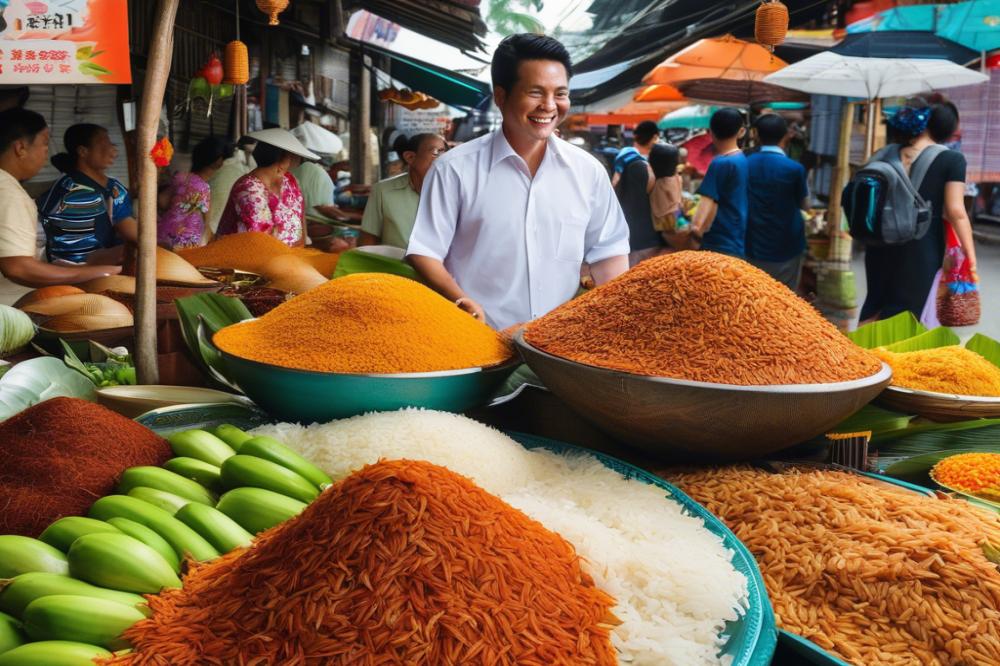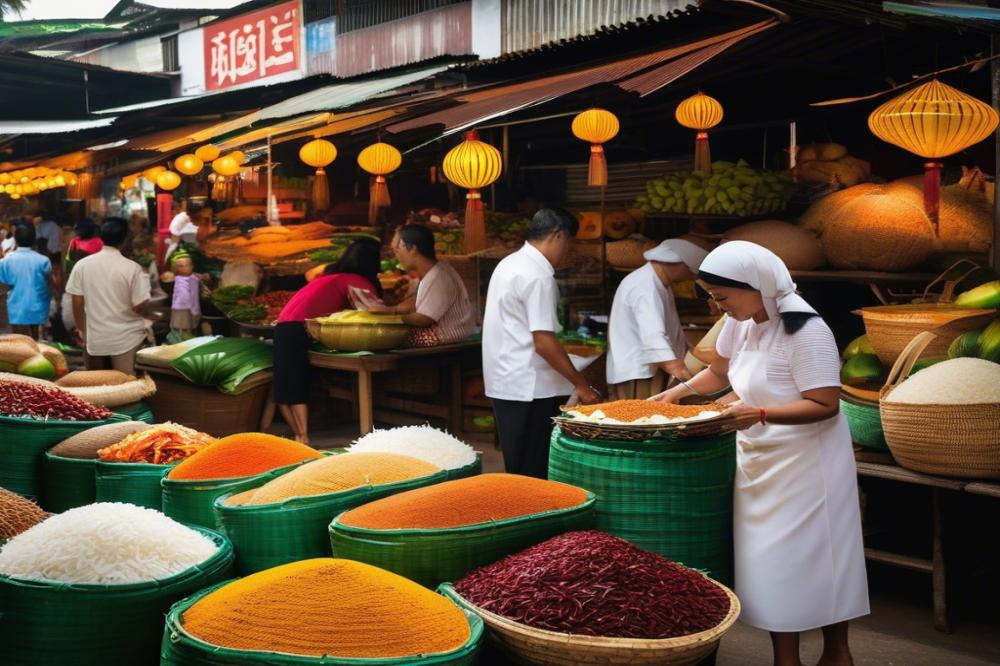Malaysian-curry-noodles”>Nasi Lemak Recipe: How to Make Malaysia’s Iconic Coconut Rice
Background on Nasi Lemak
Nasi Lemak is often celebrated as Malaysia’s national dish. This beloved meal features fragrant Coconut Rice as its base, enriched by creamy coconut milk and infused with the refreshing essence of pandan leaves. Traditionally served on a banana leaf, it exemplifies the country’s rich culinary heritage. Nasi Lemak not only pleases the palate but also highlights the diverse cultural landscapes that influence Malaysian cooking.
Importance in Culture and Street Food
The dish holds a significant place in Malaysian culture. It is cherished for its comforting flavors and versatility. Across the nation, Nasi Lemak is a common street food option, appealing to all kinds of people. Vendors often serve it with a variety of accompaniments, including sambal, hard-boiled eggs, peanuts, and cucumber to enhance its taste. Whether enjoyed at breakfast or as a late-night snack, this meal connects countless Malaysians through shared moments.
Overview of Article Contents
This article will provide a detailed recipe for making authentic Nasi Lemak at home. Step-by-step instructions will help you understand how to prepare the coconut rice and all the delicious side dishes. You’ll also discover tips for perfecting your sambal and getting the best textures from your ingredients. Join us as we explore the delightful process of creating this iconic dish, celebrating its flavorful components and cultural significance.
Nasi Lemak: A Traditional Malaysian Recipe

Nasi Lemak is one of Malaysia’s most beloved dishes. This delectable coconut rice is rich in flavor and is often considered the country’s national dish. Found in homes, restaurants, and even as street food, it truly represents the heart of Malaysian cuisine. Made with fragrant rice cooked in coconut milk and pandan leaves, Nasi Lemak is undeniably satisfying.
The history of this traditional recipe is as vibrant as Malaysia itself. Nasi Lemak has been enjoyed for generations and reflects the diverse culture of the nation. Originating as a farmer’s meal, it was easy to pack and carry. Over time, this dish has evolved and now features many regional variations, each with its own twist. For instance, in some areas, you might find it served with fried chicken or rendang, while others may include unique elements like squid or fish.
Typically, Nasi Lemak is served with sambal, a spicy chili sauce that adds a kick of heat. This fiery condiment complements the rich coconut rice perfectly. Alongside sambal, you usually enjoy a mix of side dishes. Hard-boiled eggs, crunchy peanuts, and fresh cucumber are common additions. Wrapped in a banana leaf, the presentation enhances the overall experience. The combination of flavors and textures provides an unforgettable meal.
Ingredients List and Cooking Instructions

Ingredients List
- 2 cups of jasmine rice
- 1 cup of coconut milk
- 2 cups of water
- 2 pandan leaves, tied in a knot
- 1 teaspoon of salt
- 4 hard-boiled eggs
- 1 cup of roasted peanuts
- 1 cucumber, sliced
- 1 cup of sambal, spicy chili paste
- 2 banana leaves for serving
Cooking Instructions
Start by rinsing the jasmine rice under cold water. Rinse it until the water runs clear to remove excess starch. This step is crucial for making the rice fluffy. Next, gather a rice cooker and combine the rinsed rice with coconut milk, water, and salt. Don’t forget to add the pandan leaves. Their aroma adds a special touch.
Cook the mixture according to your rice cooker’s instructions. While the rice is cooking, prepare the hard-boiled eggs. Boil them until they are well cooked but not overdone. Slice the cucumber into thin rounds. It will add a fresh crunch to the dish.
When the rice finishes cooking, take a banana leaf and lay it flat on a serving plate. Serve the fragrant coconut rice onto the leaf. Top the rice with sambal to give it a spicy kick. Add a handful of roasted peanuts for a delightful crunch. Place slices of cucumber and halved hard-boiled eggs on the side. This dish is not only a traditional recipe from Malaysia but also a popular street food that many enjoy. Each component brings its own texture and flavor, making the meal truly enjoyable.
Nutritional Information

Understanding the components of a traditional recipe like Nasi Lemak offers insight into its nutritional value. Each ingredient contributes not only to flavor but also to health benefits. Here’s a closer look at what each element brings to the table.
Nutritional Breakdown of Ingredients
Jasmine Rice: This fragrant rice forms the base of the dish. A typical serving contains around 205 calories. It is rich in carbohydrates, providing about 45 grams per cup. Protein content is low at roughly 4 grams, and fat is minimal, usually just around 0.4 grams.
Coconut Milk: Creamy and delicious, coconut milk adds richness. One cup has about 550 calories, primarily from fat. Saturated fats make up a significant portion, which can impact heart health. However, it also contains essential nutrients like vitamins C and E.
Peanuts: These crunchy delights offer healthy fats. A serving of peanuts contains about 166 calories, as well as 14 grams of fat. They also pack a protein punch, contributing 7 grams. Peanuts are rich in vitamins E and B, supporting overall health.
Hard-Boiled Eggs: Eggs are a powerhouse of nutrition. Each one provides approximately 68 calories and is an excellent source of protein, with about 6 grams. Vitamins D and B12 are also significant, playing crucial roles in energy metabolism.
Cucumber: This refreshing vegetable adds hydration to the meal. With only 16 calories per cup, cucumbers are low in energy density. They are high in vitamins K and C, which support healthy skin and bones.
Sambal: A little bit of sambal goes a long way in flavoring the dish. Caloric content varies based on the recipe, but a tablespoon typically has around 25 calories. The spicy elements can boost metabolism and enhance digestion, making it not just tasty but beneficial.
Health Benefits of the Components
Nasi Lemak ingredients together create a meal that satisfies while also being nourishing. Coconut milk provides medium-chain triglycerides, which can improve energy and fat metabolism. Peanuts contribute to heart health thanks to their monounsaturated fatty acids. This traditional dish also offers protein from eggs and peanuts, essential for muscle repair and growth.
The vitamins in cucumber and eggs support immune function and skin health. Sambal, while spicy, may help improve digestion and boost metabolism. When layered on a banana leaf, this meal becomes not only visually appealing but also an experience filled with tradition and culture. Eating Nasi Lemak is like enjoying a piece of Malaysian street food history.
Flavor Profiles and Serving Suggestions
The combination of rice, sambal, and various sides creates a truly delightful experience. Coconut rice serves as the base, lending a creamy, slightly sweet flavor. Sambal delivers a spicy kick that complements the richness of the rice. This classic dish balances three main flavors: sweet, spicy, and savory. Each mouthful brings complexity that keeps the taste buds engaged.
Side dishes complete the meal, adding variety. Hard-boiled eggs provide a subtle richness, while crunchy peanuts add texture. Fresh cucumber slices bring a refreshing contrast, cutting through the heat of the sambal. Many enjoy wrapping the rice in a banana leaf, which adds a gentle aroma while serving as a traditional touch. When enjoyed as street food, the experience feels even more authentic.
Some popular variations can elevate the dish. Fried anchovies are a common topping that adds umami flavor and a satisfying crunch. Others might choose to include beef rendang, which brings depth with its savory spices. Additionally, some people like to incorporate vegetables, further enhancing taste and color. Traditional recipes may also feature pandan leaves, infusing a pleasing fragrance into the rice.
People often customize their servings based on personal preference. Balancing all these elements allows for creativity while enjoying this iconic meal. The mix of flavors and textures can truly make each plate unique. Whether enjoyed in a home kitchen or at a bustling market, Nasi Lemak remains a beloved favorite in Malaysia.
Cultural Significance and Variations Across Malaysia
Nasi lemak holds a cherished place in the hearts of Malaysians. This coconut rice dish is not just food; it symbolizes unity and culture. During festivals and celebrations, it finds its way onto many dining tables. Families gather around it, sharing stories and laughter. The dish is often served at weddings, pushing its role beyond mere sustenance.
In Malaysia, regional variations make this meal even more interesting. In the northern states like Kedah, people often add fried chicken or beef rendang. In contrast, those in the south might serve a different type of sambal, spicier and richer in flavor. Cooking techniques can vary too. Some prefer using pandan leaves to infuse the rice with a fragrant aroma, while others stick to simpler methods. Side accompaniments, such as crunchy peanuts or fresh cucumber slices, enhance the experience and delight the palate.
Personal stories add layers to the experience of enjoying this dish. One may recall their first bite of fragrant rice wrapped in a banana leaf, memories flooding back of childhood street food adventures. A friend might talk about family picnics, where the beloved rice dish was a staple. Notes of sambal and the texture of hard-boiled eggs give life to those tales. People treasure these moments, creating bonds over a meal filled with history.
Unique interpretations also pop up in different communities. Some might enjoy Nasi lemak with fried fish, while others choose a heartier meat option. Each preparation reflects local tastes and ingredients, making every plate a story of its own. Street vendors take pride in their recipes, selling their versions to eager customers. This dish serves as a delicious reminder of Malaysia’s diversity.
Final Thoughts
Nasi lemak holds a special place in the hearts of many Malaysians. This traditional recipe is not just a dish; it is a symbol of cultural identity and heritage. Each bite offers a delightful mix of flavors that tells the story of Malaysia’s rich culinary landscape.
Trying your hand at making this beloved meal at home can be a rewarding experience. Gather your ingredients, follow the steps, and watch as your kitchen transforms into a haven of aromatic coconut rice and rich accompaniments. Sharing this meal with family or friends offers not just nourishment but also moments of joy and connection.
Embracing the culinary arts can deepen our appreciation for diverse traditions. Food has a remarkable power to bridge gaps and foster understanding. By exploring dishes like nasi lemak, we not only satiate our appetites but also honor the cultural tapestries that shape our world.


